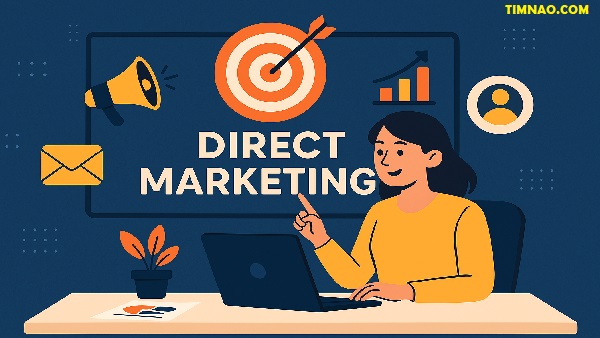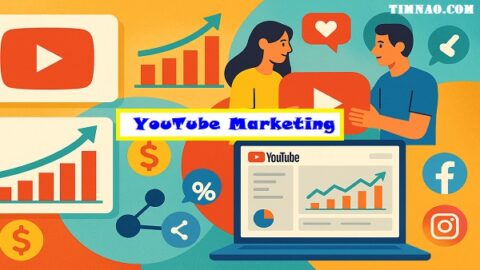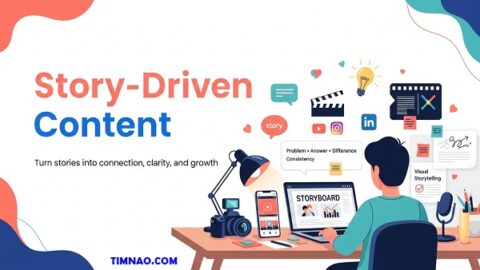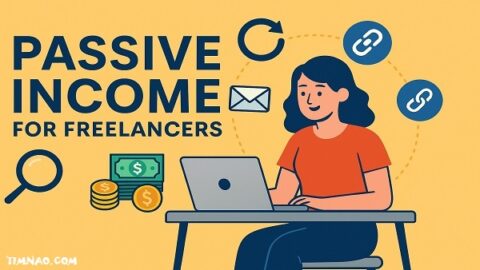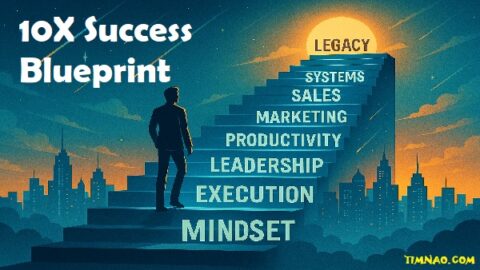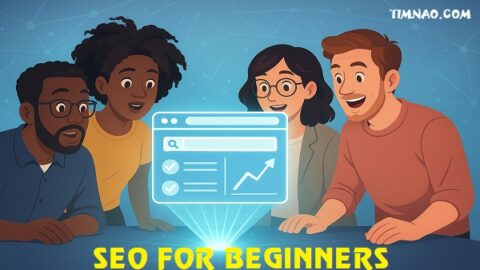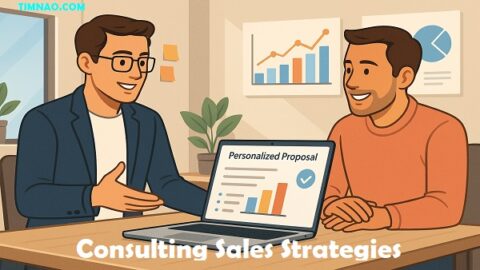The Ultimate Guide to Launching a Flawless Direct Marketing Campaign 🚀
Direct marketing might bring to mind images of dusty mailrooms and unsolicited catalogs, but in today’s digital-first world, it has evolved into one of the most powerful and profitable tools a business can wield. It’s the ultimate marketing strategy for cutting through the endless noise of mass advertising and speaking directly to the people who are most likely to become your loyal customers. This comprehensive guide is designed to be your roadmap, transforming you from a beginner into a confident marketer ready to launch a high-impact direct marketing campaign. We’ll break down everything from the psychology of a great offer to the data-driven tactics used by top brands, giving you the practical skills and a final checklist to ensure your first campaign is a massive success.
TABLE OF CONTENTS:
- 1. 🎯 What Is Direct Marketing and Why It Still Works
- 2. 🧠 The Psychology Behind Effective Campaigns
- 3. 👥 Know Your Audience Like Never Before
- 4. 💬 Messaging That Moves: Crafting Offers That Convert
- 5. 📡 Choosing the Right Channels for Direct Impact
- 6. 🔁 Traditional vs. Digital: When to Use Which
- 7. 🎁 Building Offers They Can’t Refuse
- 8. 🧩 Segment Smarter, Personalize Better
- 9. 📊 Metrics That Matter: Measuring Campaign Success
- 10. ⚠️ Common Pitfalls and How to Dodge Them
- 11. 🛡️ Ethical and Legal Boundaries You Must Not Cross
- 12. 🔗 Integrating Direct Marketing Into a Bigger Plan
- 13. 📈 Data-Driven Optimization for Better ROI
- 14. 🔬 A/B Testing for Direct Marketing Beginners
- 15. 🤖 Automation Made Easy
- 16. ❤️ From Leads to Loyalty: Build Long-Term Relationships
- 17. 🌱 Lead Generation with Direct Marketing Done Right
- 18. 📲 Tailoring Messages by Channel
- 19. 📢 Social Media’s Game-Changing Role in Direct Marketing
- 20. 🔮 Future-Proofing Your Direct Marketing Strategy
- 21. ✅ Final Checklist to Keep You On Track
1. 🎯 What Is Direct Marketing and Why It Still Works
In a world overflowing with digital ads and constant online noise, it’s easy to think that the only way to reach customers is by shouting the loudest. But what if there was a smarter, more personal way? That’s the power of direct marketing. At its core, direct marketing is a strategy where you communicate directly with a target customer or prospect, bypassing mass media intermediaries. This includes everything from a personalized email landing in their inbox to a thoughtfully designed catalog arriving at their doorstep.
The goal is simple and powerful: to trigger an immediate, measurable response. Whether it’s a sale, a sign-up for a newsletter, or a download of an app, the action is trackable, making this one of the most accountable forms of marketing. While the methods have evolved dramatically from the days of simple mail-order catalogs, the fundamental principle remains the same: it’s a one-to-one conversation, not a one-to-many broadcast.
So, why does it still work so well in 2025? In an age of data privacy concerns, direct marketing—especially physical mail—is often perceived as more trustworthy. Research shows 82% of millennials trust print advertisements more than digital ads. Furthermore, its ability to be highly targeted and personalized means you’re not wasting resources on people who aren’t interested. When you receive a message that feels like it was made just for you, you’re far more likely to pay attention and act.
2. 🧠 The Psychology Behind Effective Campaigns
A successful direct marketing campaign isn’t just about sending a message; it’s about understanding the human psychology that drives decisions. To create campaigns that resonate, you need to tap into core emotional triggers and cognitive biases that influence how people react to your offers. Great marketing feels less like a sales pitch and more like a solution that just makes sense.
One of the most powerful psychological principles in marketing is urgency. When an offer is time-limited (“Sale ends tonight!”) or scarce (“Only 50 left in stock!”), it triggers our fear of missing out (FOMO). This motivates immediate action because we are wired to avoid loss. This is a tactic you see everywhere, from flash sales on e-commerce sites to limited-time bonuses for signing up for a service.
Another key trigger is reciprocity. The idea is simple: when someone gives you something of value for free, you feel a natural inclination to give something back. In marketing, this can be a free sample, a valuable e-book, or a helpful consultation. By providing value upfront, you build goodwill and make the customer more receptive to your eventual request to make a purchase.
3. 👥 Know Your Audience Like Never Before
The single most critical element of any successful direct marketing campaign is knowing who you’re talking to. Sending a generic message to a broad audience is a recipe for wasted money and poor results. To make your marketing effective, you must develop a deep, empathetic understanding of your target customer, moving far beyond basic demographics.
Start by creating detailed customer personas. These are semi-fictional representations of your ideal customers based on real data and market research. Go beyond age and location. What are their values, hobbies, and lifestyles (psychographics)? What challenges do they face that your product solves? What motivates them? You can gather this data from customer surveys, analyzing website traffic with tools like Google Analytics, monitoring social media conversations, and examining past purchase behavior.
Once you have this rich data, you can segment your audience into smaller, more homogeneous groups. For example, instead of targeting all “fitness enthusiasts,” you could segment them into “marathon runners,” “yoga beginners,” and “home gym users.” This level of detail allows you to tailor your messaging and offers with incredible precision, making each person feel like you truly understand their unique needs and increasing the likelihood they’ll respond.
4. 💬 Messaging That Moves: Crafting Offers That Convert
With a deep understanding of your audience, the next step is to craft a message that captures their attention and compels them to act. The art of effective messaging is about clarity, relevance, and emotion. Your message must cut through the noise of daily life and connect with the recipient on a personal level.
The golden rule is to focus on benefits, not features. A feature is what your product has (e.g., “a 500-watt motor”). A benefit is what that feature does for the customer (e.g., “blend a perfect smoothie in under 30 seconds”). People don’t buy products; they buy better versions of themselves. Always frame your message around how you will improve their life, solve their problem, or help them achieve a goal.
Your message must also have a crystal-clear Call to Action (CTA). Don’t leave the recipient guessing what to do next. Use strong, action-oriented language like “Get Your Free Trial,” “Shop the Sale Now,” or “Download the Guide.” Make it obvious and easy for them to take the next step. Every piece of your communication, from the email subject line to the final sentence, should guide them toward this single, desired action.
5. 📡 Choosing the Right Channels for Direct Impact
Crafting the perfect message is only half the battle; you also need to deliver it through the right channels. The channels you choose will significantly impact your campaign’s reach, cost, and effectiveness. The best marketing strategy involves selecting channels based on where your target audience spends their time and how they prefer to receive information.
The main channels for direct marketing include:
- Email Marketing: This remains a powerhouse due to its low cost and high ROI. It’s perfect for sending personalized newsletters, promotional offers, and nurturing customer relationships over time. Tools like Mailchimp or Klaviyo make it easy to manage and automate.
- Direct Mail: In a digital-first world, a physical piece of mail can stand out. Postcards, letters, and catalogs have impressive open rates (often over 80-90%) because they offer a tangible experience. It’s particularly effective for high-value offers or for reaching demographics less active online.
- Telemarketing: While it has a mixed reputation, a direct phone call can be highly effective for complex products, B2B sales, or relationship-building. It allows for immediate, two-way conversation and feedback.
- SMS/Text Messaging: With phenomenal open rates, SMS is unbeatable for time-sensitive promotions, appointment reminders, and flash sale alerts. The message must be concise and offer clear, immediate value.
- Social Media: Platforms like Facebook, Instagram, and LinkedIn offer powerful tools for direct messaging and highly targeted advertising, allowing you to engage with customers in a dynamic and interactive environment.
6. 🔁 Traditional vs. Digital: When to Use Which
The choice between traditional (direct mail, telemarketing) and digital (email, social media) marketing isn’t an “either/or” decision. The most powerful strategies in 2025 often integrate both to create a seamless customer experience. Understanding the unique strengths of each will help you allocate your budget effectively.
Digital direct marketing shines when it comes to speed, cost, and analytics. You can launch an email campaign in minutes, reach a global audience instantly, and track every click in real-time. The advanced targeting capabilities of platforms like Google and Meta allow for incredible precision, maximizing your ROI. The main challenge is cutting through the immense digital clutter and an ever-growing sense of “ad blindness” among consumers.
Traditional direct marketing, particularly direct mail, offers a powerful antidote to digital fatigue. A physical item has a staying power that an email doesn’t; it can sit on a counter for days, providing multiple impressions. Research consistently shows direct mail has higher brand recall (75% vs. 44% for digital ads) and is often perceived as more trustworthy. While the upfront cost is higher and measurement can be more complex, its impact can be profound, especially when integrated with a digital component like a QR code or a personalized URL.
7. 🎁 Building Offers They Can’t Refuse
At the heart of every great direct marketing campaign is an irresistible offer. This is the core value proposition that motivates a person to stop what they’re doing and take action. An offer isn’t just a product; it’s a carefully constructed package of value, urgency, and persuasion designed to be so compelling that the customer feels they would be foolish to ignore it.
A truly irresistible offer has several key components:
- High Perceived Value: The customer must feel they are getting a deal that is significantly better than the standard offering. This can be achieved through discounts (“50% Off Today Only”), bundling (“Buy a laptop, get a printer free”), or adding exclusive bonuses.
- A Strong Sense of Urgency or Scarcity: Humans are wired to act when they fear missing out. Phrases like “Offer expires in 24 hours,” “Limited to the first 100 customers,” or “While supplies last” create a powerful incentive to act now rather than later.
- Risk Reversal: One of the biggest barriers to a purchase is the fear of making the wrong decision. You can eliminate this fear by offering a strong guarantee, such as a “30-day money-back guarantee” or “Free returns, no questions asked.” This transfers the risk from the customer to you, making the decision to buy much easier. A great example is online mattress companies like Casper, which built their entire business model on a 100-night risk-free trial.
8. 🧩 Segment Smarter, Personalize Better
If you treat all your customers the same, you’re leaving money on the table. Segmentation is the process of dividing your broad audience into smaller, more defined groups based on shared characteristics. Personalization is the art of tailoring your message to those specific segments, making each communication feel relevant and personal. Together, they are the jet fuel for a high-performing marketing strategy.
You can segment your audience based on several criteria:
- Demographics: Age, gender, income, location.
- Psychographics: Lifestyle, values, interests, personality.
- Behavioral: Past purchase history, website activity (pages visited, items clicked), email engagement.
Once segmented, personalization can begin. This goes far beyond just using a customer’s first name. True personalization uses behavioral data to create a unique experience. For example, Amazon‘s recommendation engine is a masterclass in this, showing you products “based on your recent viewing history.” According to McKinsey, 71% of consumers now expect personalization, and companies that excel at it can see a lift in sales of 5-15%.
9. 📊 Metrics That Matter: Measuring Campaign Success
One of the greatest advantages of direct marketing is its measurability. Unlike broad brand advertising, you can track the performance of every campaign and calculate your return on investment with precision. To do this, you must identify and monitor the right Key Performance Indicators (KPIs). These are the specific, quantifiable metrics that tell you whether you are achieving your goals.
For any direct marketing campaign, these are the essential KPIs to track:
- Response Rate: The percentage of people who took any action in response to your message (e.g., clicked a link, scanned a QR code). This tells you if your message and offer were engaging.
- Conversion Rate: The percentage of people who completed the ultimate desired action (e.g., made a purchase, filled out a form). This is the true measure of your campaign’s persuasiveness.
- Cost Per Acquisition (CPA): This is the total cost of your campaign divided by the number of new customers you acquired. A lower CPA means your campaign is more efficient. For e-commerce in 2025, average CPAs can range from around $53 for food & beverage to over $77 for home goods.
- Return on Investment (ROI): This is the ultimate bottom-line metric. It’s calculated as
((Revenue from Campaign - Cost of Campaign) / Cost of Campaign) x 100%. Direct marketing channels consistently post strong ROI, with email marketing averaging an incredible $42 for every $1 spent. - Customer Lifetime Value (CLV): This metric predicts the total net profit your company will make from a single customer over the entire duration of your relationship. A successful marketing strategy not only acquires customers but acquires customers who will stay and spend more over time.
10. ⚠️ Common Pitfalls and How to Dodge Them
Even the most well-planned campaigns can fail if they fall into common traps. Being aware of these potential mistakes is the first step to avoiding them and ensuring your marketing efforts are as effective as possible.
Here are some of the most critical pitfalls to watch out for:
- Poor Segmentation and Lack of Personalization: Sending a generic, one-size-fits-all message is the fastest way to be ignored. If your message doesn’t feel relevant to the recipient, it will be discarded without a second thought. How to avoid it: Invest time in analyzing your data and creating clear audience segments.
- Unclear Message or Call to Action (CTA): If your audience is confused about what you’re offering or what you want them to do, they will do nothing. Ambiguity is the enemy of conversion. How to avoid it: Keep your message simple, direct, and focused on a single, clear objective with an unmissable CTA.
- Ignoring Measurement and Testing: If you don’t track your results, you’ll never know what’s working and what’s not. You’ll be stuck repeating the same mistakes and wasting your budget. How to avoid it: Define your KPIs before you launch and use A/B testing to continually optimize every element of your campaign.
- Excessive Communication: Bombarding your audience with too many messages leads to “marketing fatigue.” This can cause them to tune you out, unsubscribe, or develop a negative perception of your brand. How to avoid it: Monitor your communication frequency and give users control over how often they hear from you.
11. 🛡️ Ethical and Legal Boundaries You Must Not Cross
In today’s data-driven world, trust is your most valuable asset. Operating ethically and legally is not just a requirement—it’s fundamental to building a sustainable brand that customers respect and want to do business with. Violating these boundaries can lead to hefty fines, legal trouble, and irreparable damage to your reputation.
The two most important legal frameworks to be aware of are:
- General Data Protection Regulation (GDPR): This European Union law governs data protection and privacy for all individual citizens of the EU and EEA. It requires you to have a lawful basis for processing personal data, which often means getting explicit, unambiguous consent before sending marketing communications.
- California Consumer Privacy Act (CCPA): This gives California residents greater control over their personal information, including the right to know what data is being collected about them and the right to have it deleted.
Beyond specific laws, ethical marketing means being transparent, honest, and respectful. Don’t use misleading subject lines or deceptive claims. Make it easy for people to unsubscribe from your communications. Always treat your customers’ data with the same care and respect you would want for your own. Building a foundation of trust will pay dividends in long-term customer loyalty.
12. 🔗 Integrating Direct Marketing Into a Bigger Plan
Direct marketing is incredibly powerful on its own, but its effects are amplified when it’s integrated into a cohesive, multi-channel marketing strategy. A siloed approach, where your email team doesn’t talk to your social media team, leads to a disjointed and confusing customer experience. The goal is to create a unified brand voice across all touchpoints.
Effective integration means your channels work together to reinforce the same message. For example:
- A customer sees a targeted ad for a new product on Instagram.
- They click through to your website but don’t buy.
- The next day, they receive a personalized email with a small discount on that exact product.
- A week later, a beautifully designed postcard arrives in their mail with a QR code that takes them to a video demonstrating the product’s benefits.
This omnichannel approach surrounds the customer with a consistent and compelling narrative, increasing the chances of conversion. Research from 2024 shows that campaigns combining direct mail and digital media see a lift in response rates of up to 118%. Tools like a Customer Data Platform (CDP) can help unify your customer data from all channels, making this level of coordinated marketing possible.
13. 📈 Data-Driven Optimization for Better ROI
The difference between good and great marketing often comes down to data. In the digital age, we have access to an unprecedented amount of information about customer behavior. The key is to move beyond simply collecting data and start using it to generate actionable insights that drive continuous improvement and maximize your return on investment.
The process is a continuous loop:
- Collect Data: Gather information from every touchpoint—website analytics, CRM systems, email campaign results, social media engagement, and customer feedback.
- Analyze and Identify Patterns: Use analytics tools to sift through the data and find trends. Are customers from a certain city more likely to buy a specific product? Do emails sent on Tuesday mornings have a higher open rate?
- Form a Hypothesis: Based on your analysis, make an educated guess about how you could improve performance. For example, “I hypothesize that adding customer testimonials to our landing page will increase the conversion rate.”
- Test and Measure: Use A/B testing to validate your hypothesis.
- Implement and Iterate: Apply what you’ve learned to your broader strategy and start the cycle over again.
This data-driven approach removes guesswork from your marketing. Every decision is backed by evidence, ensuring you are constantly refining your strategy to be more efficient and effective.
14. 🔬 A/B Testing for Direct Marketing Beginners
A/B testing (or split testing) is one of the most powerful and fundamental tools for optimizing your marketing campaigns. It’s the process of comparing two versions of a single variable to see which one performs better. It’s a simple, scientific way to let your audience tell you what they prefer, taking the guesswork out of your creative decisions.
Here’s how it works for a beginner:
- Pick One Variable to Test: It’s crucial to only test one thing at a time so you know what caused the change in performance. You could test:
- An email subject line
- The color of a CTA button
- The main image in an ad
- The specific offer (e.g., 20% off vs. free shipping)
- Create Two Versions (A and B): Version A is your control (the original), and Version B is your variation.
- Split Your Audience: Randomly divide a segment of your audience in half. Send Version A to one half and Version B to the other half.
- Measure the Results: Track your key metric (e.g., open rate, click-through rate, conversion rate) for both versions.
- Analyze and Implement: The version that performed better is your winner. Use that winning version for the rest of your audience and make it the new control for your next test.
By constantly running small tests like this, you can achieve significant, compounding improvements in your campaign performance over time.
15. 🤖 Automation Made Easy
Marketing automation uses software to automate repetitive marketing tasks, allowing you to deliver personalized experiences at scale without manual effort. It’s not about sending robotic messages; it’s about using technology to be more timely, relevant, and human. In 2025, 75% of businesses are using at least one form of marketing automation, and for good reason—it boosts lead generation, improves efficiency, and drives revenue.
Here are some simple automation workflows you can set up today using platforms like HubSpot or ActiveCampaign:
- Welcome Series: When a new user subscribes to your list, automatically send them a sequence of 3-4 emails over a week. The first can be a warm welcome, the second can share valuable content, and the third can present a special newcomer offer.
- Abandoned Cart Reminders: This is a must-have for e-commerce. If a customer adds an item to their cart but leaves without buying, an automated email sent a few hours later can recover a significant portion of that lost revenue. The top-performing abandoned cart emails can generate nearly $29 in revenue per recipient.
- Birthday/Anniversary Emails: Automatically send a personalized greeting and a special offer on a customer’s birthday or the anniversary of their first purchase. This is a simple but incredibly effective way to build goodwill and drive repeat sales.
16. ❤️ From Leads to Loyalty: Build Long-Term Relationships
The most successful businesses don’t just focus on acquiring new customers; they obsess over keeping the ones they have. It costs significantly more to acquire a new customer than to retain an existing one, and loyal customers spend more over time. The ultimate goal of your marketing strategy should be to convert first-time buyers into lifelong brand advocates.
Building long-term relationships requires a shift in mindset from transactional to relational. It’s about consistently providing value even when you’re not actively selling. Strategies for fostering loyalty include:
- Exceptional Customer Service: Be responsive, helpful, and empathetic. Turning a negative experience into a positive one is one of the most powerful ways to earn a customer for life.
- Loyalty Programs: Reward customers for their repeat business. This can be a simple points system, tiered rewards, or exclusive access to products and sales. A great example is Sephora’s Beauty Insider program, which offers points, free birthday gifts, and a strong sense of community.
- Valuable Content: Go beyond product promotions. Share useful tips, educational content, or entertaining stories that are relevant to your audience’s interests. This positions you as a trusted resource, not just a seller.
- Personalized Communication: Remember their preferences and purchase history. A simple “We thought you might like this” based on a past purchase shows you’re paying attention and makes the customer feel valued.
17. 🌱 Lead Generation with Direct Marketing Done Right
Lead generation is the lifeblood of business growth. It’s the process of identifying and cultivating potential customers (leads) for your products or services. A direct marketing approach is exceptionally well-suited for lead generation because it allows you to offer something of value in exchange for a prospect’s contact information, starting a direct line of communication.
Effective lead generation strategies include:
- Lead Magnets: Offer a valuable piece of content for free in exchange for an email address. This could be an e-book, a checklist, a webinar, or a whitepaper. The key is that the content must solve a specific problem for your target audience.
- Optimized Landing Pages: Drive traffic from your ads or emails to a dedicated landing page with a single, clear purpose: to capture a lead. The page should have a compelling headline, a concise description of the offer, and a simple form to fill out.
- Contests and Giveaways: Run a contest on social media or via email where entry requires providing contact information. This can be a highly effective way to rapidly build your email list.
- Lead Scoring: Not all leads are created equal. Use a lead scoring system to rank leads based on their engagement and demographic data. This allows your sales team to focus their efforts on the prospects who are most likely to convert, making the entire process more efficient.
18. 📲 Tailoring Messages by Channel
You wouldn’t speak the same way at a formal business meeting as you would on a casual text message thread. The same principle applies to your marketing channels. To maximize effectiveness, your message must be adapted to the specific context, expectations, and technical limitations of each platform.
Here’s how to adapt your message for different channels:
- Email: You have more space here. Use compelling subject lines to get the open, and a mix of engaging text and visuals to tell a story and drive to a clear CTA.
- SMS: This is all about brevity and immediacy. Messages should be short, to the point, and contain a clear, urgent call to action. It’s perfect for flash sales or shipping notifications.
- Direct Mail: You can be more creative with the physical format. Use high-quality paper, compelling imagery, and personalized elements to create a premium feel. Make the key benefit and offer impossible to miss at a glance.
- Social Media: This channel is highly visual and interactive. Use eye-catching images or short-form videos to stop the scroll. Write in a more conversational tone and encourage engagement through questions, polls, and comments.
While the delivery changes, your core brand message and tone should remain consistent across all channels to build strong brand recognition.
19. 📢 Social Media’s Game-Changing Role in Direct Marketing
Social media has fundamentally transformed the landscape of direct marketing. It has evolved from a simple networking tool into a powerful platform for direct-to-consumer communication, engagement, and sales. In 2025, social media is no longer optional; it’s an essential component of a modern marketing strategy.
Social media amplifies direct marketing in several key ways:
- Hyper-Targeted Advertising: Platforms like Facebook and Instagram offer incredibly granular ad targeting, allowing you to reach precise demographic and psychographic segments with your message.
- Direct Engagement and Customer Service: Social media provides a public, real-time channel for customer interaction. Brands can answer questions, resolve issues, and build a community around their products. This two-way dialogue strengthens customer relationships in a way that traditional one-way communication cannot.
- Social Commerce: With features like Instagram Shopping and TikTok Shop, the path from discovery to purchase has become seamless. Customers can buy products directly within the app, turning social platforms into powerful sales channels.
- Influencer and Creator Collaborations: Partnering with creators allows you to tap into their trusted relationship with a niche audience. This form of “borrowed trust” can be far more effective than traditional advertising. The creator economy is a major trend for 2025 and beyond.
20. 🔮 Future-Proofing Your Direct Marketing Strategy
The world of marketing is in constant flux. To stay relevant and effective, you must keep an eye on emerging trends and be willing to adapt your strategy. Future-proofing your direct marketing means embracing new technologies and evolving with consumer expectations.
Here are the key trends shaping the future of direct marketing:
- Artificial Intelligence (AI): AI is moving beyond simple automation to power hyper-personalization at scale. By 2025, AI will be standard for predicting customer needs, dynamically personalizing content, and optimizing ad spend in real-time.
- Immersive Experiences (AR/VR): Augmented Reality (AR) is becoming a powerful tool for bridging the digital and physical worlds. Think virtual try-ons for clothing and makeup or visualizing furniture in your own home. These immersive experiences provide real utility and create highly memorable brand interactions.
- Privacy-First Marketing: As consumers become more aware of data privacy, brands must be more transparent and ethical in their data practices. A focus on first-party data (information collected directly from your customers with their consent) will be crucial.
- Sustainability and Values-Driven Marketing: A growing number of consumers, especially younger generations, want to buy from brands that align with their values. Communicating your commitment to sustainability and social responsibility is no longer a niche strategy—it’s a core component of building brand trust and loyalty.
21. ✅ Final Checklist to Keep You On Track
Before you launch your next direct marketing campaign, run through this final checklist. It consolidates the key principles from this guide and serves as a last line of defense against common mistakes, ensuring you’ve set yourself up for success.
- Clear Objective: Have you defined a single, specific, and measurable goal for this campaign?
- Audience Understood: Do you know exactly who you’re talking to, what they care about, and why they should listen to you?
- Irresistible Offer: Is your offer compelling, clear, and designed to remove risk and create urgency?
- Personalized Message: Is your message tailored to your audience segment? Does it speak to their benefits, not just your features?
- Channels Aligned: Have you selected the best channels for your audience and adapted your message for each one?
- Integration Plan: If using multiple channels, do they work together to tell a cohesive story?
- Legal & Ethical Compliance: Does your campaign fully respect customer privacy and comply with regulations like GDPR?
- Testing in Place: Have you set up an A/B test for at least one critical element (e.g., subject line, CTA)?
- Tracking Confirmed: Are all your analytics and tracking pixels set up correctly to measure your KPIs?
- Feedback Loop Ready: Do you have a plan to collect and analyze customer feedback to improve future campaigns?
By thoughtfully checking each of these boxes, you can launch your campaigns with confidence, knowing you’ve built a strategy that is poised to connect, convert, and create lasting customer relationships.

